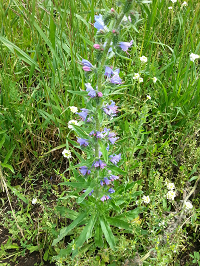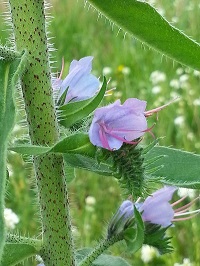Blueweed- January 2019
Download weed post on blueweed as a PDF (contains word scramble!)
Introduction
While blueweed may look beautiful, this non-native is not palatable to livestock and has toxic alkaloids that can cause liver failure. This species was introduced from southern Europe and is now widely distributed throughout North America. Blueweed is a priority 1B noxious weed in Montana and has infested over 8,800 acres as of 2016. It has been found in 11 counties in Montana.
Identification and biology

Photo by Jane Mangold.
Blueweed is a member of the Boraginaceae family, the same family containing houndstongue. Blueweed is a biennial or short-lived perennial forb that has a large, deep taproot with smaller fibrous roots. A basal rosette initially grows with leaves 2.5 to 10 inches long. Then plants grow one to many erect, branching, flowering stems that can be over 3 feet tall (photo right). Stem leaves are alternate and become smaller towards the top of the stem. Both stems and leaves are covered with short, spreading hairs that have swollen reddish-purple bases, giving stems a spotted appearance (photo below). This is a good diagnostic feature for blueweed. Funnel-shaped flowers form along helicoid cymes, which are flower structures that are curled like a scorpion’s tail. Flowers are typically bright blue but can be purple, pink, or rarely white. Another identifying characteristic of blueweed is the five pink or red stamens which protrude out from the inside of the flower.
Habitat and spread
Blueweed is typically found in wastelands or disturbed areas, along roadsides, and in overgrazed pastures. Blueweed reproduces solely by seeds, which can be dispersed via wind, water, animals, and humans. Seeds are small but rough, so they can attach to animal fur and be transported that way.
Impacts

Photo by Jane Mangold.
Blueweed can cause a skin rash in humans when the stem or leaves are touched, so gloves should be worn if handling the plant. Blueweed contains pyrrolizidine alkaloids, which can be toxic to horses and cattle when ingested. While this plant is not considered highly palatable, livestock may ingest blueweed if the surrounding vegetation is limited or in poor condition.
Management options
Proper maintenance of vegetation and soil is the best way to prevent the invasion and establishment of blueweed. If you have a smaller infestation of blueweed, hand pulling or digging will work, especially if the soil is moist. Since blueweed has a big taproot, make sure you get the majority of the root system so it can’t regenerate. There are no approved biological control agents in the United States for blueweed. Herbicide trials on a rangeland site in Ravalli County were successful in controlling blueweed with metsulfuron, chlorsulfuron, or their combination. Herbicides were applied to rosettes in the spring or fall. Other herbicide options include 2,4-D or Crossbow® (2,4-D + triclopyr). Always consult product labels and read them carefully to ensure correct usage and rates. Revegetation after herbicide application may be necessary to establish competitive vegetation, especially at highly disturbed sites.
For more information on blueweed, see “Biology, Ecology, and Management of Blueweed” EB0195
